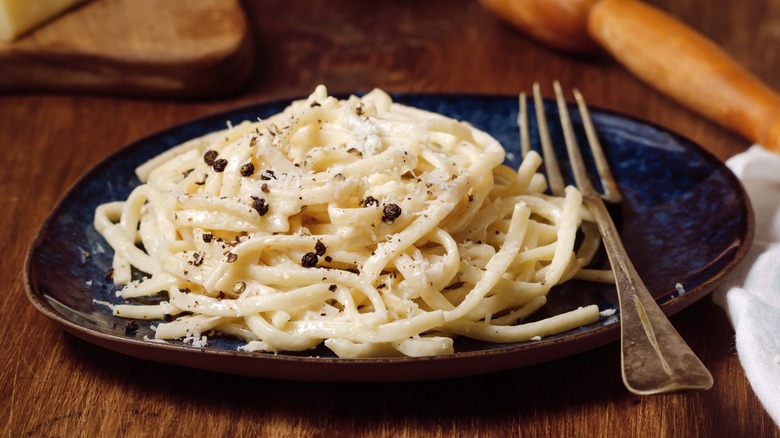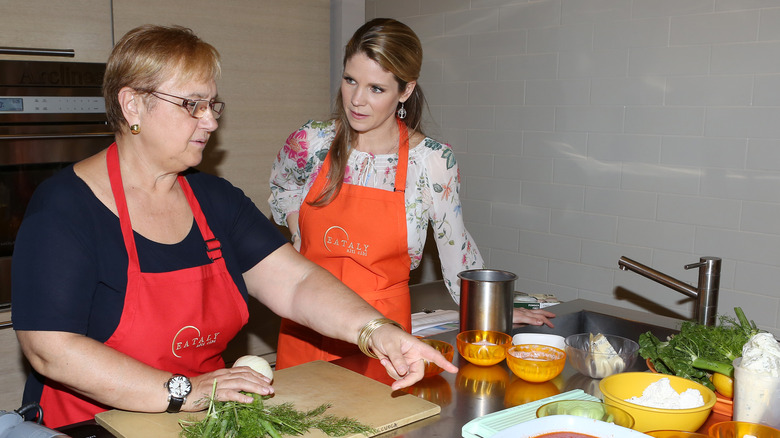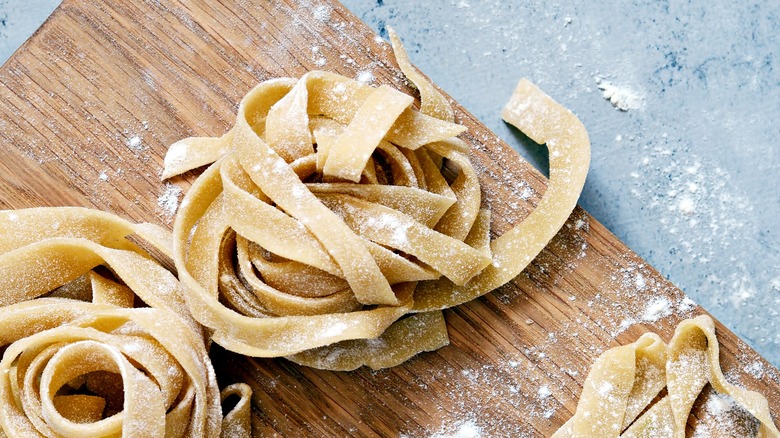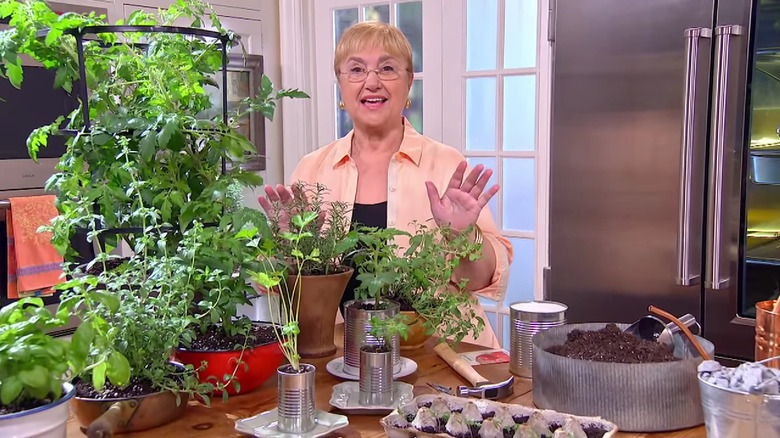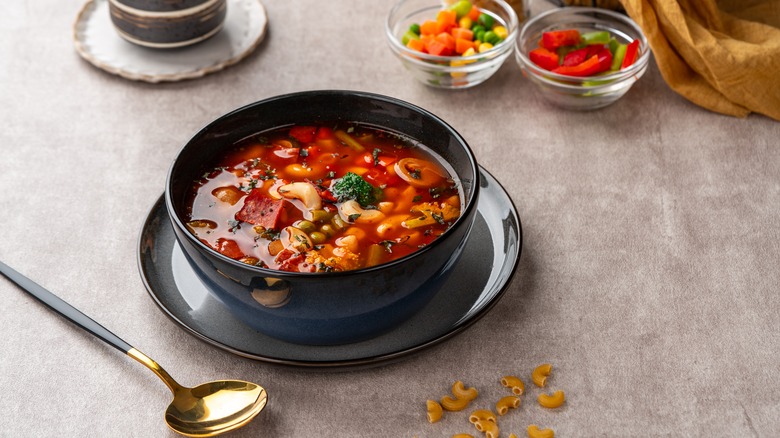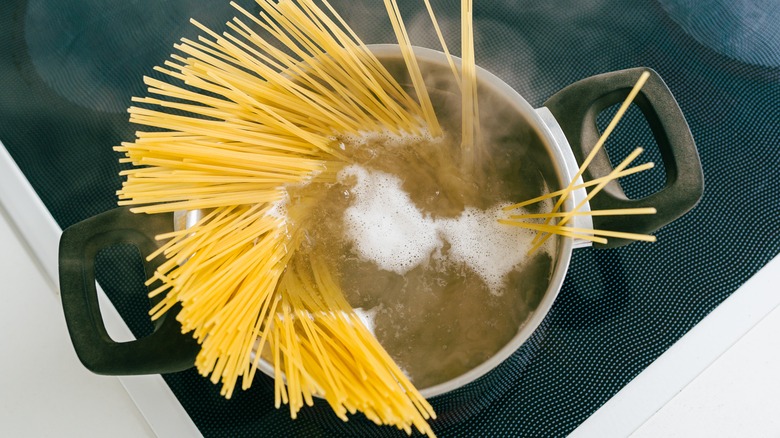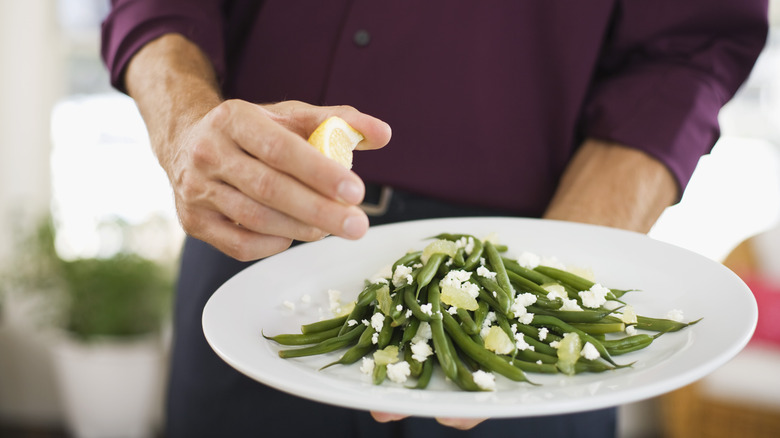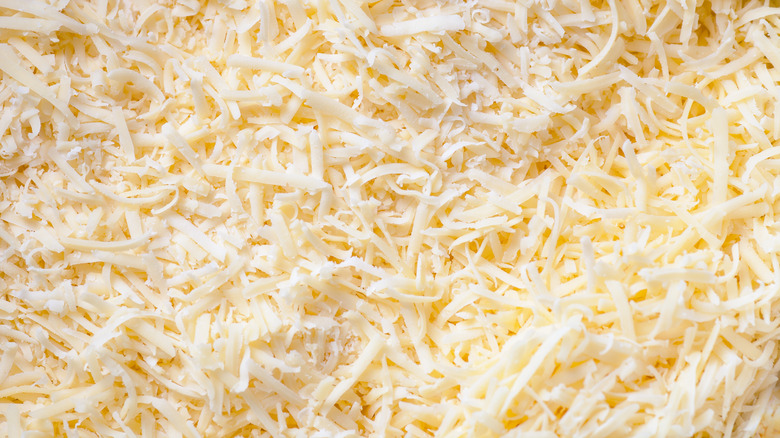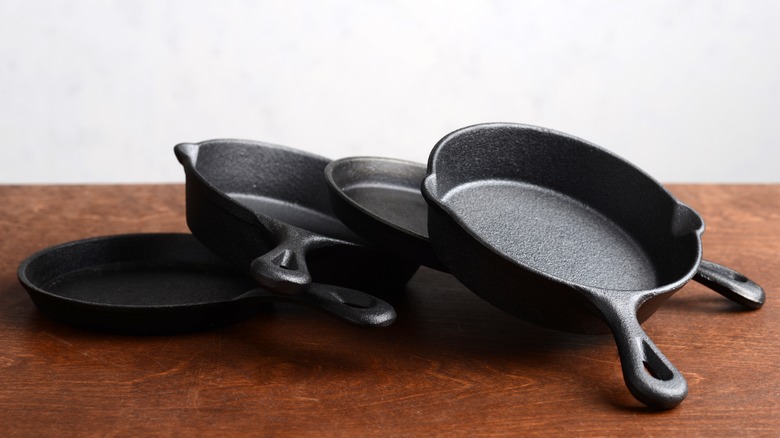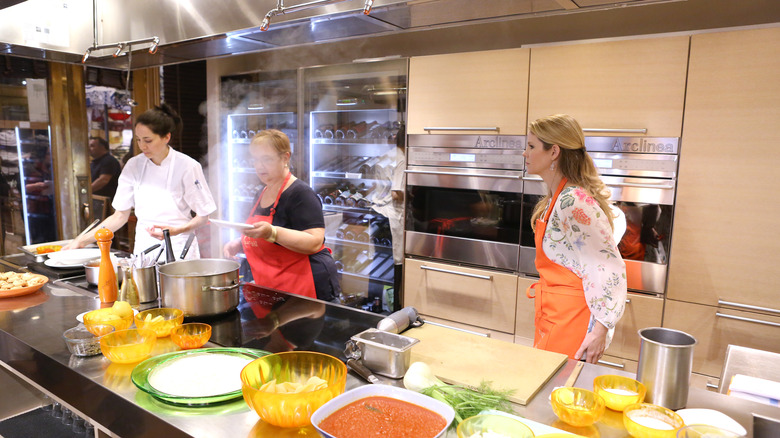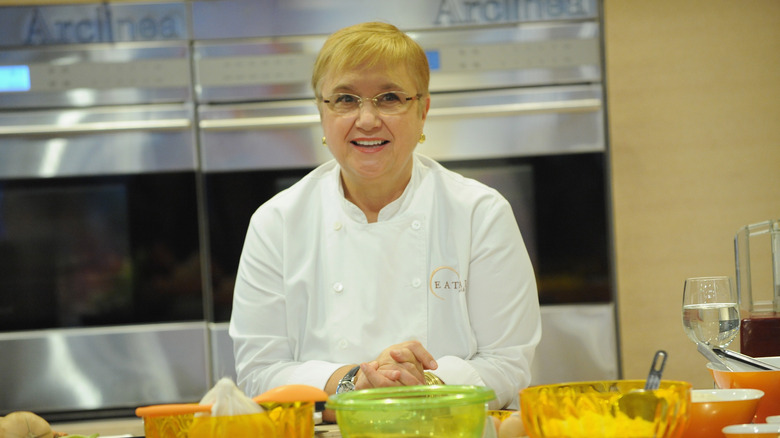Lidia Bastianich's 12 Best Cooking Tips
Lidia Bastianich's life's story is an incredible one. Born in Istria, Bastianich and her family fled during the Istrian exodus. Bastianich first ended up in a refugee camp in Italy. From there, her family traveled to the United States, settling in New York.
During this early period of her life, Bastianich developed a love for cooking. Through diligent practice she transformed this passion into a skill and then a subsequent career. Today, Bastianich is a restaurateur, best-selling cookbook author, and Emmy-winning TV host. She is even seen as the individual who almost single-handedly introduced Americans to regional Italian cuisine.
With so much experience in the kitchen, Bastianich has a wealth of knowledge when it comes to all things cooking. In this article, we have collected the pieces of Bastianich's advice we deem most important. From practical guidance concerning pasta water to ruminations on the connection between culture and the kitchen, Bastianich has many pearls of wisdom that will benefit all aspects of your cooking.
1. Keep your food simple
As a staunch advocate for Italian cuisine, Lidia Bastianich believes in keeping food simple. That means using a few ingredients well. Not only is this the secret to many Italian classics like cacio e pepe, but it also helps make cooking a practice that is approachable for all. Bastianich explained this idea to Mashed: "Everybody can cook something. Simple. Start with the recipes with three ingredients, four ingredients. And, you know, read the recipe ... and I'm sure it will be a success [...] Trust yourself in the kitchen. And start simple."
Keeping food simple doesn't just mean using few ingredients. Minimizing the number and difficulty of cooking techniques also allows nervous home cooks to whip up high-quality food. As a chef that has dedicated her life to championing simple, regional Italian dishes like the aforementioned cacio e pepe, Bastianich understands this. She advises all cooks to reduce the excessive flourishes that can overcomplicate dishes — advice that many cooks, professional and amateur, would do well to heed.
2. Don't be overly systematic
Lidia Bastianich is a woman that likes to cook with her heart. This means putting love and care into all steps of the cooking process. Part of this approach is trusting your gut and making spontaneous decisions. For example, adding a little more salt or a sprinkling of cheese, even if the recipe does not call for it.
The antithesis of Bastianich's approach to food is a systematic method where recipes are rigidly followed. This is an all too common issue, as Bastianich highlighted in an interview with USA Today. "I think people make it [cooking] too systematic in a way, like it's a chemistry formula," she said. "Food is not like that; food is very forgiving. Connecting and making do with a lot of the food elements can be fun and exciting."
Of course, cooking by feel is easier said than done, especially for those new to the kitchen. Yet, as a skill that can be developed through practice, we would advise all cooks to invest their time in learning it. While initially difficult, we agree with Bastianich that cooking by feel is superior to strictly following a recipe. After all, if you adopt her approach that food is forgiving and cooking is an exciting experiment, you will enjoy both cooking and eating a great deal more.
3. Use pasta made with semolina flour
As an Italian national, pasta holds a special place in Lidia Bastianich's heart. Unsurprisingly, it is also one of the main subjects fans ask her about. Bastianich has many tips when it comes to cooking pasta, one of which we will touch on later. But before the cooking process begins it is vital that the right type of pasta is sourced. For Bastianich the best type of pasta is exclusively made with semolina flour. "Make sure that [the pasta] it's made from 100 percent semolina flour ... because it has more proteins, more gluten in it," she said in an interview with Wisconson Publish Radio. "Then you look at the pasta ... it shouldn't be shiny, it's a little opaque, you want the pasta to be rough, you don't want a smooth, dry pasta because the sauce just slips right off."
Semolina flour is made from hard wheat grains that — when ground — result in a coarser flour. In terms of pasta, this coarseness translates into a rough texture. As Bastianich highlighted, this allows more sauce to grip to the pasta, resulting in more flavorful mouthfuls. What's more, its high gluten content means semolina pasta keeps its shape better during the cooking process. The pasta also carries a number of health benefits including high fiber and protein content.
4. In a pinch, frozen vegetables will work fine
A YouGov poll in 2022 found that the vast majority of global consumers believe fresh produce to be superior to frozen. This belief is strongest in the Americas; YouGov reports that 78% of the two continent's inhabitants prefer fresh over frozen. However, Lidia Bastianich disagrees. In an interview with GBH News she stated, "Green vegetables everyone loves, but they're always hard to maintain. Frozen vegetables are perfectly fine. Frozen peas, frozen fava, frozen broccoli stems — perfectly fine."
Bastianich is not alone in the belief that frozen can be as good as fresh. The Independent reports that many celebrity chefs have long championed the economic accessibility, practicality, and quality of frozen vegetables. What's more, frozen vegetables have proven to be as nutritionally sound as their fresh counterparts. In some cases they are even superior. For example, peas retain a greater proportion of vitamins when frozen immediately after picking as opposed to being sold and consumed fresh, per The Guardian. Of course, there are many scenarios where fresh produce is the obvious choice, including the making of salads. But you shouldn't feel pressure to only use fresh ingredients in your kitchen. After all, Bastianich doesn't.
5. Cook and eat what is in season
As a keen gardener, it is no surprise that Lidia Bastianich values the seasonality of ingredients. This appreciation was instilled in her while watching her grandmother grow and cook produce. "Well, I think there were rules, I guess, dictated by nature — timing, maybe climate, or whatever — that she followed and she respected," she said. "That was the seasonality. And we knew exactly what was coming and we were getting ready for what was coming. And [I remember] how she tried to capture these flavors," (via Mashed).
Italian cuisine itself is built upon the concept of seasonality. Traditionally, certain products are celebrated while at their best and not widely used during other times of the year. However, the rise of global supply chains has ensured a year-round supply of many ingredients for those living in the United States and beyond. As such, seasonality has fallen by the wayside.
The benefits of cooking with seasonal produce are many-fold. From a cooking perspective, the primary one is taste. Seasonal produce is packed full of flavor that requires little to no embellishing. Instead, the product's naturally-occurring flavors carry the dish. A prominent example of this would be Italy's caprese salad. This is a dish of unbeatable flavor when made with perfectly ripe, in-season tomatoes; it is also one that can be underwhelming when made during the winter months.
6. Connect to your culture
What we cook and eat is an expression of who we are and where we come from. For Lidia Bastianich this is vitally important as cooking gives us a means of connecting with our own culture. In an interview with SheKnows she said, "I think we all should feel special about who we are. You can celebrate your food traditions every day with simple recipes. Stay seasonal, stay local and stay simple. Incorporate your own ethnicities into a meal but put some excitement and challenge into it. Bring home what you see elsewhere. You don't have to copy it, but you can build upon it with your own touch."
As Bastianich explains, connecting to your culture does not require elaborate recipes. Instead, we can pay homage to our roots through the daily action of cooking and eating. What form this takes will differ for every person. La Cucina Italiana reports that Bastianich connects with her Italian culture through the almost daily cooking of hearty, rustic soups like minestrone.
7. Do not add oil to your pasta water
The trend of adding oil to pasta water is an enduring one. Many home cooks believe that the addition of slick oil prevents pasta strands from sticking together.Oil disrupts the surface tension of pasta water, which stops it from boiling over even when exposed to heat for prolonged periods.
Lidia Bastianich is not a fan of this culinary practice. When speaking to Wisconsin Public Radio she said, "Never, never, never put oil in the water. Oil will coat your pasta and will inhibit the sauce to grasp on to your cooked pasta." She is correct; when this hydrophobic layer of oil coats the pasta it limits the amount of sauce that the strands can pick up. As pasta is primarily a vessel for sauce, this limits its functionality and ultimately results in a worse quality meal being eaten.
If you are constantly suffering from pasta water boiling over, lower the temperature. To prevent it from sticking together make sure the water is at a rolling boil before the pasta is added. Stirring the noodles as they cook will also ensure that the strands do not stick together.
8. Add some flavorful ingredients after cooking
Cooking can be viewed as the careful layering of flavors and textures. In order to maximize our culinary skills it is vital that we understand how cooking processes alter both. For example, the knowledge that browning meat adds depth of flavor and crispness can be used to create a better beef bourguignon. But while many cooks are aware that cooking adds flavor, fewer understand that heat can also diminish it.
Lidia Bastianich explained this idea for two ingredients, butter and cheese. "If you add it at the last minute, the flavor is retained and it really kind of whips up. The same for the cheese," she said in an interview with Epicurious. However, if exposed to too much heat these same ingredients lose their flavor and have limited impact on the dish. The same can also be said for lemon juice, which is brilliantly bright when added before serving. However, during the cooking process it can lose flavor, its brightness, and turn bitter.
Understanding that these flavorful ingredients are negatively impacted by excessive exposure to heat allows you to add them at the time when they will have the most impact. For example, only squeezing fresh lemon juice over a finished dish. This will allow you to capitalize on the full range of flavors available and ultimately improve your dish.
9. Don't be tempted by pre-grated cheese
While Lidia Bastianich believes in making cooking easy and accessible for all, she does not support all culinary shortcuts. One time-saving product Bastianich suggests avoiding is pre-grated cheese. In a video uploaded to her YouTube account, Bastianich states, "Always buy your grating cheese in chunks rather than already grated, it stays much fresher that way. You should grate your own cooking and serving cheese simply because it is fresher, and you know exactly what you are getting. Grate your cheese as close as possible to use. Pre-grated cheese oxidizes fast and loses flavor."
What Bastianich didn't mention is that some pre-grated cheeses contain surprising ingredients. Store-bought pre-grated cheese has been shown to include both cellulose and preservatives. While these ingredients are not harmful they indicate a doctored product that is of lower quality than whole cheese. As lower quality usually results in less flavor it is wiser to buy a block and grate it yourself.
10. Take into account what equipment you are using
We have seen how the season, processing level, and cooking techniques can all impact the quality of your food. When speaking to Parade, Lidia Bastianich was also eager to point out another variable — cooking equipment. "The vessel used to cook definitely makes a difference. Cast iron pots, which distribute the heat evenly are good, but you have to be mindful and control the heat. I like enamel covered pots for braising and soups; deep roasting pans with enamel coating are also a favorite of mine."
When deciding what equipment to use it is important to know what you are trying to achieve. For example, cast iron cookware is a great choice if browning meat is the goal. This is because of the material's ability to radiate a great amount of heat. On the other hand, enamel-lined cooking equipment is perfect for more gentle and prolonged cooking methods — like slow-cooking stews — thanks to the material's non-porous nature.
If you do not own the perfect piece of equipment do not worry; the vast majority of cookware is extremely versatile. Just be sure to factor in the differences between materials by tweaking the recipe. For example, when browning meats in enamel-lined cookware you may need to use a higher temperature than when using regular cast iron.
11. Share your cooking traditions with others
We have already seen that Lidia Bastianich advocates for expressing culture through cooking. But she does not want cultural expression to stop there. Rather, she encourages people to exchange their culture and cuisines with one another. This gives individuals exposure to flavors, ingredients, and practices they have never experienced. In turn, this may ultimately result in something new and exciting being created. When speaking to She Knows, Bastianich said, "As a chef, I contemporize recipes that are traditional. What's beautiful about tradition is that the flavors bring you to a certain place and time and you want to bring those memories to your table. Eventually, the flavors you bring into your home will repeat themselves with your new family, and there is your tradition. For example, if curry is a flavor from your culture, use it in a different way, like in a burger. Why not! It's one element that ties it back to your tradition."
Combining flavors is just one way of sharing and creating cooking traditions. Another would be to experiment with traditional cooking techniques. For example, an Indian chef teaching an Italian American about tarka could result in them devising a completely new dish, one that champions the traditions of both Italian-American and Indian cuisines.
12. Always trust your taste
With constant exposure to cooking programs, foodie Instagram posts, and an unfathomable number of recipes it can be easy for home cooks to always follow the guidance of others. While initially harmless, an overreliance on exterior guidance can see the trust in our own skills and faculties dwindling. For example, if a sauce lacks something many of us would sooner turn to Google than try solving it with our own taste buds.
Lidia Bastianich advocates for the opposite; she is always encouraging cooks to trust their culinary skills and above all their own sense of taste, a notion she explained to WNYC. "We have an apparatus, which is our mouth, which is quite telling," she said. "To each of us, it tells a different story because we have a different story. So I think it's pretty safe to say that everybody should sit down, and [...] look for the aroma, the intensity in the mouth, the viscosity in the mouth, and what they love."
In other words, if you don't like how something tastes, think about what might be missing and try a few things out. After all, as Bastianich is always quick to highlight, cooking should be a fun, loving, and freeing practice. Not something to worry, stress, or agonize over.
Static Media owns and operates Daily Meal and Mashed.

